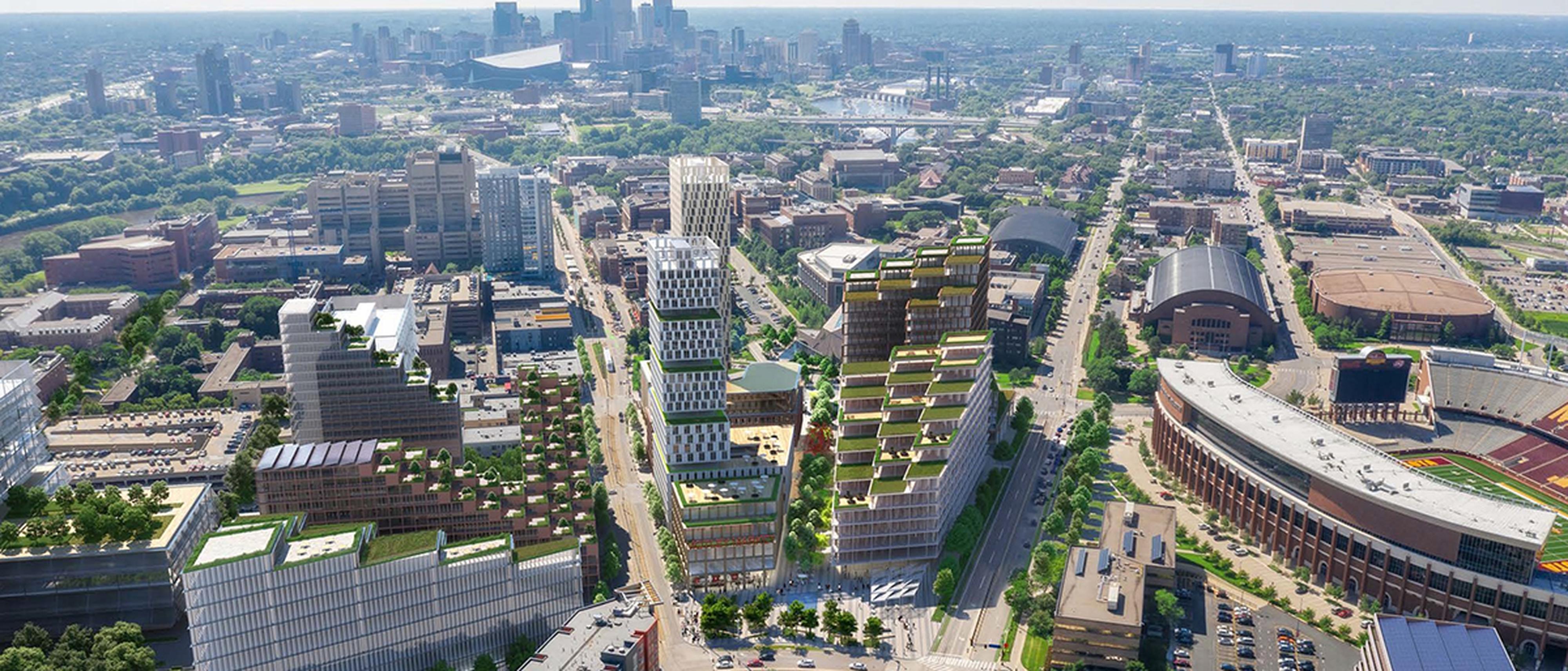
What is The Minnesota Innovation Exchange?
The Minnesota Innovation Exchange (The MIX) will be an anchor for the University's innovation district, a place where industry, government, community, the University, and other research institutions will come together to create a new hub for discovery and economic activity in the region. When complete, The MIX will feature approximately three million developed square feet with a variety of uses: research and development, particularly for medicine and life sciences, meeting/conference space, multifamily residential, hospitality, restaurant, entertainment, and similar destination spaces.
Where is it?
The University of Minnesota’s innovation district sits at the eastern edge of the Minneapolis Twin Cities East Bank campus. Already, innovation-focused facilities such as those in the Biomedical Discovery District have given the area a reputation as a home for groundbreaking research. Nearby landmarks are Huntington Bank Stadium and the McNamara Alumni Center. This East Gateway area is alive with social activity and just steps from some of the most important research and scholarship happening anywhere in the country. The longer-term vision for the area also includes a new state-of-the-art hospital and clinical campus that will be better connected to the University’s East Bank campus, the Mississippi River, and surrounding neighborhoods.
Why is The MIX important?
This is a once-in-a-generation opportunity to use real estate to drive a convergence of public and private entities. When scientists, innovators, educators, businesses, and communities come together in the spirit of discovery, there are infinite possibilities for making the world a better place. The MIX will combine the idea-generation and research success of the University with the experience and expertise of industry in scaling and commercializing innovations.
How can companies benefit?
Industry partners who take advantage of opportunities in The MIX can expect a unique set of benefits to help grow their business.
1. Proximity to world-class researchers and facilities
This development puts companies alongside some of the world’s most talented researchers and problem-solvers. The research specialties available to industry will be curated according to the University’s strongest programs.
2. Potential for R&D partnerships
This proximity gives companies a powerful new partner for their R&D efforts. And partnership is key, because the University’s expertise in developing promising ideas needs industry’s expertise in bringing them to market to truly effect the positive change and growth we all envision.
3. Access to future workforce
This location also provides access to tens of thousands of undergraduate and graduate students who will graduate with a high-quality education and will be looking to work for top local companies. They will be an integral part of the community that grows up around this development, whether by working and researching in the space, or by taking advantage of the neighborhood amenities.
4. Sense of community and belonging
For employees who work out of these facilities, it will feel like much more than a workplace. Interesting shops and restaurants, as well as year-round programming will help attract talent and make people look forward to coming to work in a vibrant, diverse community.
How can companies get involved in The MIX?
Businesses looking to take advantage of the University’s research expertise and gain exposure to the future workforce in UMN’s student population can consider becoming an anchor tenant or co-locating in The MIX.
Facilities geared toward business interests include:
- Labs, featuring leading-edge technology and equipment
- Offices and meeting spaces to support in-person and hybrid work models
- Auditorium and conference spaces to host industry gatherings
- Talent development space, especially for students, with a focus on entrepreneurism
- “Collision” and informal meeting spaces (hospitality and public realm)
How can I learn more about The MIX?
Corporate leaders interested in learning more about how this place-based innovation initiative could advance their business can send an email to [email protected] and a Corporate Engagement Center contact will respond promptly.